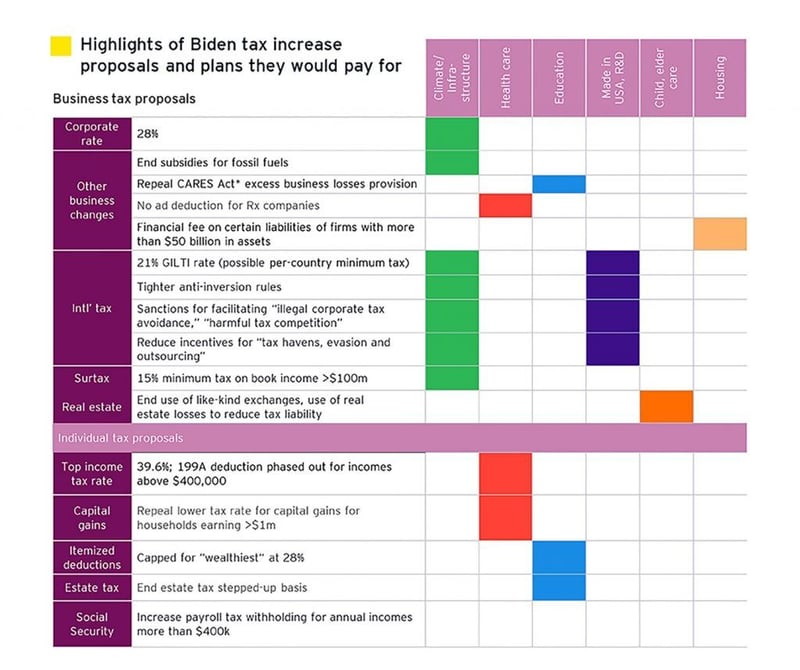
This article is
courtesy of EY
Author: Ray Beeman
A Biden presidency and Democratic Senate could bring change
to the course of tax policy.
In brief
- The 2020 presidential election season has been
anything but typical. - Mainstay election issues are being viewed
through a crisis lens: reopening the economy is at odds with curbing viral
spread, creating economic uncertainty. - A Biden victory and Democratic control of the
Senate may mean a focus on tax issues to stimulate the economy, perhaps through
increased investments and R&D.
The 2020 presidential election season has been anything but
typical with the unprecedented circumstances of the coronavirus pandemic and a
focus on racial injustice. Mainstay election issues of the economy and health
care are viewed through the lens of crisis: reopening the economy is at odds
with curbing the spread of the virus, and that tension has created economic
uncertainty that the nation is not likely to completely get beyond for some
time. How tax and economic policy will be addressed if Democrats are in control
in 2021 is gaining attention.
The dawn of the pandemic capped a primary season that saw
Democratic candidates draw from a wide menu of tax policy ideas, from
unrealized Obama-era proposals to newer plans like wealth taxes. Presumptive
Democratic nominee Joe Biden had a relatively modest tax platform and has
gotten ahead while hanging back. Most of his economic proposals were presented
as revenue sources for climate, health and education plans last year. While he
has not released a single campaign tax plan, what has been put forward largely
harkens back to the Obama-era, pre-Tax Cuts and Jobs Act (TCJA) playbook: tax
increase proposals from a time when deficits from the previous recession were
the subject of fierce partisan battles.
Making wealthy individuals and corporations “pay their fair
share” has long been a touchstone for Democrats. Mindfulness of where the
economy is in early 2021, however, may temper calls for tax increases in the
near term. Leaders like Senate Finance Committee ranking member Ron Wyden
(D-OR) have said if they have new power in the presidency and/or Senate
majority in 2021, they will first act to repair economic damage before
increasing taxes for the sake of fairness.
Similarly, if the economy is ailing, raising taxes for
deficit reduction may take a back seat given that deficit concerns have largely
been pushed aside in responding to the crisis. Likewise, if President Trump
wins reelection and Republicans still control the Senate, any focus on tax is
likely to be refining and/or making permanent TCJA provisions, not addressing
deficits.
A Biden victory could bring control of the Senate along with
it. An early focus on tax would likely be on stimulating the economy, perhaps
through investments in manufacturing, supply chains, infrastructure and clean
energy, as well as via R&D for technologies like electric vehicles, 5G and
artificial intelligence. Democrats could also seek to bolster public safety net
programs − Biden recently announced a plan on childcare and similar needs — and
address outstanding health care priorities, as well as enact any coronavirus
response measures not agreed to in 2020. These plans could be proposed along
with tax increases, likely rolling back parts of the TCJA and ending the lower
capital gains rate, though some may be deemed stimulus and not paid for.
A Senate Democratic majority probably would be narrow, and
Democrats would likely need to turn to the budget reconciliation process that
allows certain legislation to pass with 51 votes, rather than the 60-vote
filibuster threshold, for a major economic bill that doesn’t have broad
bipartisan support. (That is, unless a new Senate Democratic majority seeks to
change Senate rules regarding the filibuster.) Even with that procedural
advantage, getting to 51 votes could be difficult given splits in ideology
among moderate and progressive Democrats that will play a large role as the
party tries to move on legislation.
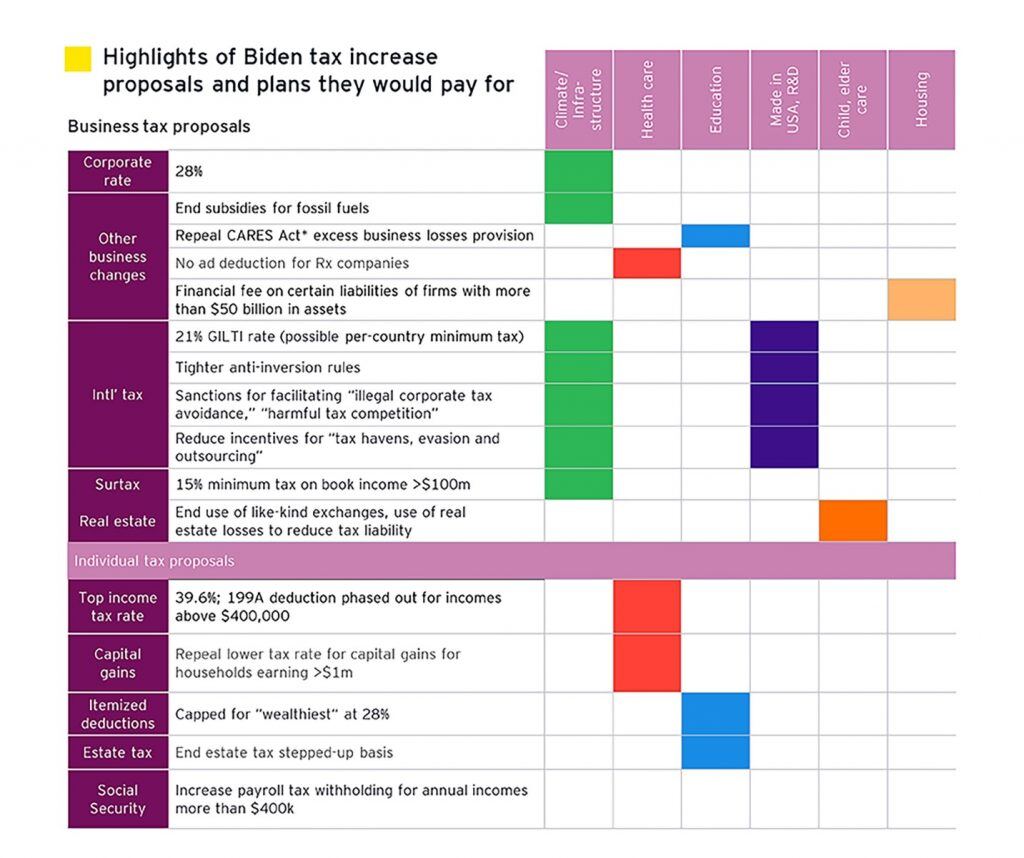
Shaded blocks show how revenue from the various proposals
would be spent.
Business Tax
The 28% corporate rate proposed by Biden was targeted by the
Obama administration when it discussed doing tax reform in 2015 and 2016,
though it was never formally proposed in an Obama Administration budget. Some
more progressive Democrats, including several who ran in the Democratic
presidential primaries, have proposed raising the corporate rate all the way
back to 35%. However, it seems as if the political ceiling is 28%. Along with
raising the corporate rate, Biden has called for a “minimum corporate tax” of
15% applying to book income for companies with net income greater than $100
million.
In the international context, Biden has joined many other
Congressional Democrats in calling for changes to the global intangible
low-taxed income (GILTI) rules, believing it does not have enough teeth to
prevent US companies from taking undue advantage of other international tax
changes included in the TCJA that partially eliminated US tax on foreign-source
earnings.
Biden has proposed combining the 28% corporate tax rate with
a 21% tax rate on GILTI, so he seems to concede that GILTI should be taxed at a
rate lower than the corporate tax rate, but other Democrats have proposed
taxing GILTI at the full US corporate tax rate. Importantly, Biden would go a
step further, joining some other Democrats in proposing to apply GILTI on a
jurisdictional basis, rather than an aggregate basis as it currently applies.
Democrats supporting such a move will find good company with the Organisation
for Economic Co-operation and Development’s efforts to develop model minimum
tax legislation under Pillar 2 of the Base Erosion and Profit Shifting 2.0
project that also appears likely to include a per jurisdiction approach. All
these ideas seemed to be aligned with Democrats’ stated desire to remove
incentives for companies to shift US jobs and physical operations overseas.
As part of a housing plan, Biden proposed a financial fee on
certain liabilities of firms with more than $50 billion in assets. No further
details were provided, but it appears the proposal would be modeled after the
Financial Crisis Responsibility Fee proposed by President Obama.
Regarding real estate investment, Biden proposed to pay for
childcare improvements by ending the use of like-kind exchanges and use of real
estate losses to reduce tax liability. Addressing 1031 exchanges is among the
alternatives to a wealth tax put forward by other Democrats, and Biden appears
poised to go the base-broadening, loophole-closing route.
Individual
Individual tax proposals were some of the first put forward
when the campaign kicked off in April 2019. “Let’s get rid of capital gains
loopholes for multimillionaires,” Biden said, adding that capital gains
treatment was behind an Obama-era quote from Warren Buffett that he should not
pay a lower tax rate than his secretary. The lower rate for dividends would
also be repealed, according to campaign officials.
Biden has stated that tax increases won’t affect families
earning less than $400,000 annually. He has also reportedly proposed phasing
out above that dollar limit the Section 199A qualified business income
deduction available to individuals, including many owners of sole
proprietorships, partnerships and S corporations.
Not all of Biden’s proposals are tax increases. He has also,
in some of the same plans that call for tax provisions as revenue offsets,
proposed to extend, revive or create tax incentives.
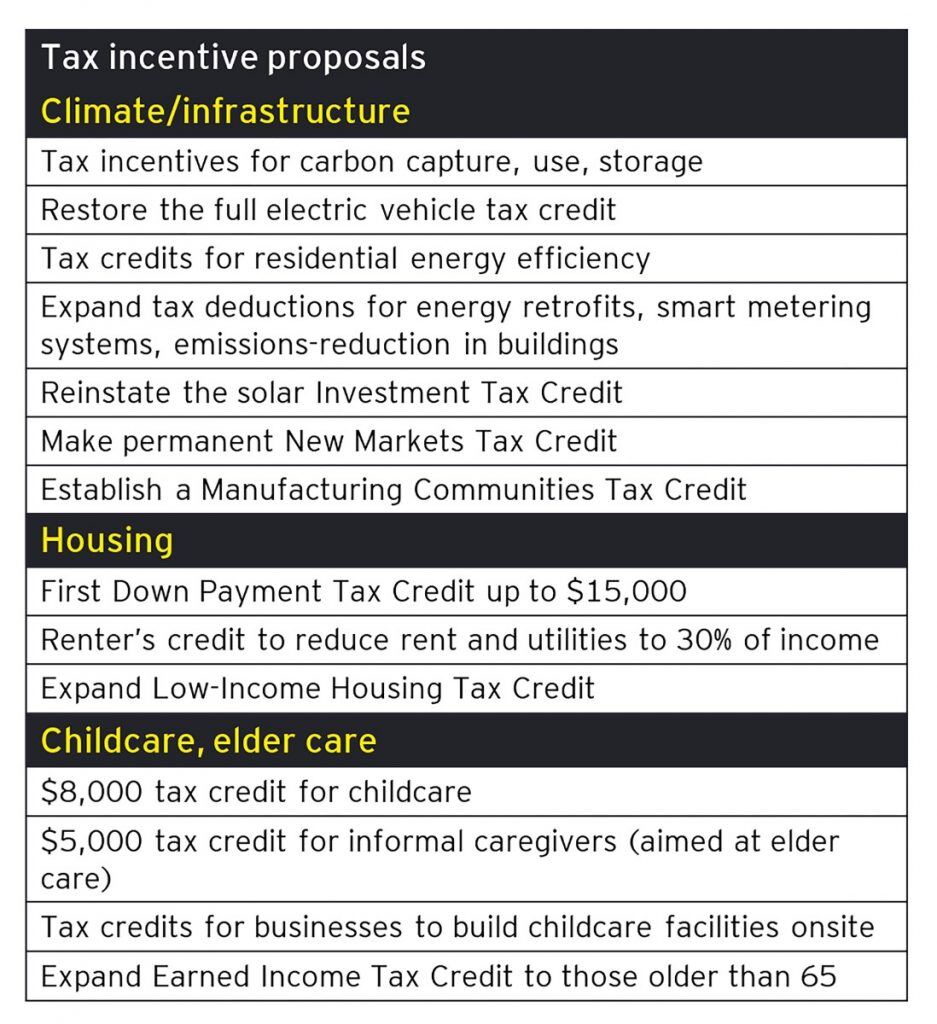
Revenue
The revenue impact of the Biden campaign’s proposals have
only been scored by nongovernmental think tanks, which have tallied them at or
near $4 trillion in tax increases: $3.8t by both the American Enterprise
Institute (AEI) and Tax Foundation, and $4t by the Tax Policy Center (TPC).
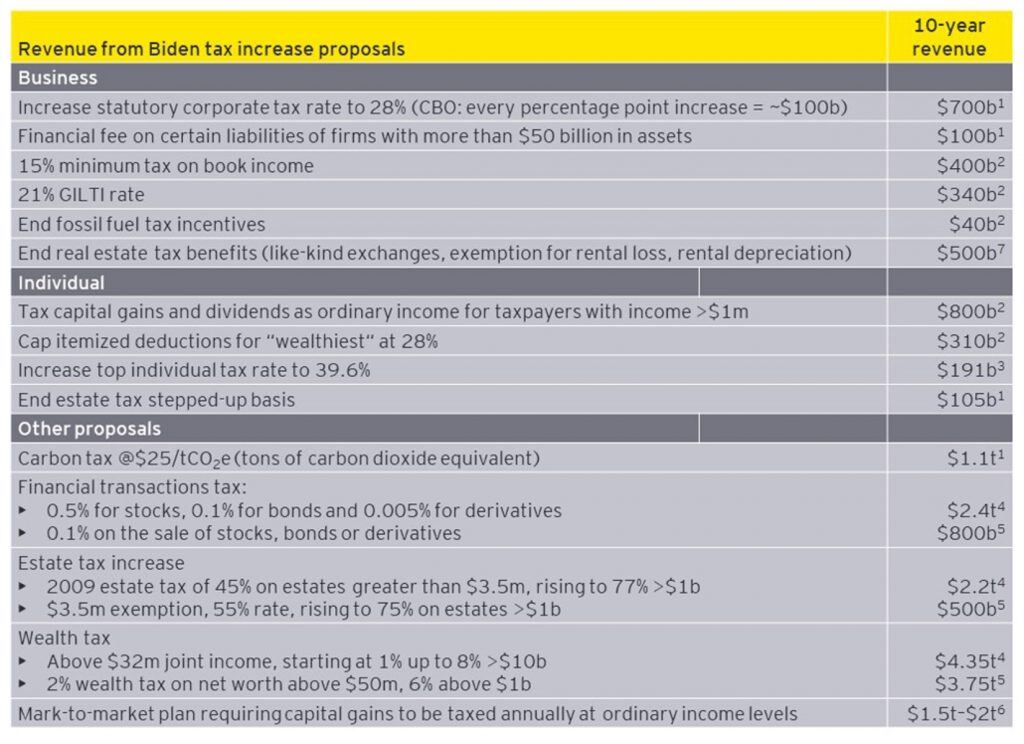
TPC analysis
The nonpartisan Tax Policy Center said about half of that
revenue gain would come from higher taxes on high-income households and about
half would come from higher taxes on businesses, especially corporations. In
the TPC’s breakdown, Biden’s proposal to increase the corporate tax rate to 28%
accounts for about one-third of the additional revenue over 10 years, while
applying Social Security taxes to earnings above $400,000 accounts for about
25%. Increased taxes on capital gains and dividends accounts for another 11%,
and repealing the TCJA’s tax cuts for taxpayers with incomes above $400,000
raises a similar amount (11%). Biden would spend more than $270b of that
revenue on tax credits and income exclusions for family caregiving, retirement
saving, student loan forgiveness, energy efficiency, renewable energy and
expanding the electric vehicle fleet.
Distributionally, TPC said Biden’s plan would raise taxes on
households with income of more than $837,000 (i.e., the top 1%) by an average
of about $299,000, or 17.0% of after-tax income. By contrast, TPC said
taxpayers in the middle-income quintile would see an average tax increase of
$260.
AEI
The conservative-leaning American Enterprise Institute’s
analysis of Biden’s tax proposals found that altogether, his policies
would raise about $3.8t over 10 years, slightly lower than the TPC analysis.
AEI estimated that Biden’s most significant tax increases would fall on the top
1% of earners and “overall … make the US tax code more progressive.”
Like TPC, AEI found that the highest-income filers would
produce most of the new revenue, projecting that 72% of new tax revenue in 2021
would come from the top 1% of tax filers, whose after-tax income would fall by
17.8%, with an average tax increase of $118,674. AEI said nearly all the income
and payroll tax increases in Biden’s proposals target the top 1%; tax increases
for the bottom 99% are largely due to business tax hikes.
The conservative Tax Foundation said the Biden tax plan
would reduce GDP by 1.51% over the long term. The group said the plan would
shrink the capital stock by 3.23% and reduce the overall wage rate by 0.98%,
leading to 585,000 fewer full-time equivalent jobs. The group found that on a
dynamic basis, the plan would raise about 15% less revenue than on a
conventional basis over the next decade. Dynamic revenue gains would total
approximately $3.2 trillion between 2021 and 2030 because the relatively
smaller economy would shrink the tax base for payroll, individual income and
business income taxes.
On macroeconomic effects, AEI forecasts that Biden’s tax
policies would reduce the level of US gross domestic product (GDP) relative to
the baseline by 0.06% from 2021 to 2030 by reducing labor supply and capital stock.
AEI estimated that higher effective tax rates on high-income households and
corporations would cause a short-run reduction in GDP, followed by a medium-run
increase due to the reduction in debt.
Other Democratic proposals
The Biden plan has thus far left out some of the more
progressive tax revenue proposals that emerged during the primary campaign
season, including a wealth tax. But many members of Congress will also have
ideas beyond, and to the left, of what he has proposed.
A financial transactions tax has had support in Congress and
was picked up by other candidates. Sen. Brian Schatz (D-HI) and Rep. Peter
DeFazio (D-OR) sponsored the Wall Street Tax Act of 2019 (S. 647, H.R. 1516) to
impose a 0.1% a tax on securities transactions. Sen. Bernie Sanders’ (I-VT)
bill (S. 1587), cosponsored by Sen. Kirsten Gillibrand (D-NY) would impose a
financial transactions tax of 0.5% for stocks, 0.1% for bonds and 0.005% for
derivatives.
Senator Wyden, who would likely become chairman of the
tax-writing Finance Committee should Democrats take control of the Senate, has
proposed a plan to impose a mark-to-market approach requiring capital
gains to be taxed annually at ordinary income levels.
“Anti-deferral [mark-to-market] accounting rules” would only
apply to individuals with more than $1m in annual income or $10m in assets.
Applicable taxpayers would be required to pay annual taxes on unrealized gains
and take a deduction for unrealized losses on liquid assets, such as stock,
while for illiquid assets mark-to-market would not apply but a look-back charge
would be imposed on gains realized upon the sale of these assets.
Biden hasn’t proposed estate tax changes beyond eliminating
stepped-up basis, but Biden-Sanders “unity” principles released in July said
they should be “raised back to the historical norm.” Democrats have at times
urged a return to the 2009 regime: $3.5m exemption and 45% rate. Interest
remains in repealing the $10,000 state and local tax deduction cap.
The
economy in 2021
At the beginning of 2021, it is likely that the focus will
be on reviving the economy while still tending to the demands of the
coronavirus. It is possible more virus-related relief will be needed, or that
Democrats, if in control, would try to enact some of the measures that
President Trump and Senate Republicans have not agreed to in coronavirus
measures. There are several tax items in the House-passed Health and Economic
Recovery Omnibus Emergency Solutions Act that are not likely to be agreed to by
Republicans this year, and so could be ripe for action if Democrats control
Washington in 2021:
- Making the child tax credit fully
refundable, increasing the amount to $3,000 per child ($3,600 for a child
under age 6), and making 17-year-olds qualifying children - Making the child and dependent care
tax credit fully refundable and increasing the maximum credit rate to 50% - Increasing the exclusion for dependent care assistance
from $5,000 to $10,500
There will also be a focus on recovery and job creation.
Biden has said that if elected, he would provide “further immediate relief” to
families, small businesses and communities dealing with the coronavirus
pandemic.
In terms of stimulus, Biden has thus far outlined plans to
invest a combined $700b in procurement and R&D designed to boost US
manufacturers and stimulate the economy, as well as $2t in clean energy and
infrastructure investment. In both cases, Biden has emphasized the job-creation
benefits of the plans and the campaign has signaled they would be partially
paid for by reversing tax cuts for corporations and impose “common-sense tax
reforms that finally make sure the wealthiest Americans pay their fair share.”
Probably the best model for a united government coming into power amid a crisis
was President Obama working largely with the Democratic Congress on financial
rescue and recovery in 2009. The new president had campaign tax proposals, but
those largely were jettisoned initially to focus on recovery.
If racial economic equality is an early priority, Biden has
proposed opportunity zone changes in a context that focuses on creating jobs
for low-income residents and otherwise providing a direct financial impact to
households, as well as additional review of and reporting by opportunity zone
recipients.
He
also proposed making permanent the New Markets Tax Credit.
At some point, however, tax increases will likely be
proposed for what is already a massive revenue hole from the coronavirus. The
Congressional Budget Office (CBO) on April 24 said the FY2020 budget
deficit is projected to be $3.7t. The deficit was $864b just for June.
Also inevitable: a discussion over the future of Social Security, with the
troubling outlook for the program over at least the past two decades now even
worse with an aging population and the payroll and other economic effects of
the pandemic, which some say accelerates the insolvency date by about a year.
Biden proposes to impose Social Security payroll taxes on incomes greater than
$400,000 per year, in addition to the first $137,000 in annual income, with no
additional tax on income in the doughnut hole in between.
Principles
behind Democratic tax policy
The “fair share” principle goes back to the Obama
administration and has continued in the wake of the TCJA, which Democrats
say tilted benefits toward corporations and wealthy individuals. While
Democrats are seen as having won the 2018 congressional elections largely on
the issue of health care, they were also highly critical of the TCJA.
Now-Speaker Pelosi criticized the tax bill for adding to the deficit, saying
lawmakers should “make the middle-class tax cuts permanent” but “bring balance”
to the tax system and reduce debt “by having a revenue package that does just
that, that puts the middle class first.” She also suggested the 21% corporate
income tax rate is too low. Democrats are likely to stick to these principles.
While Democrats back making permanent most TCJA provisions
for individuals that expire after 2025, it is less clear how they will approach
business changes/phase-outs sooner:
- The 30% limitation on the deduction of
interest expense is calculated without depreciation and amortization after
2021 (i.e., earnings before interest and taxes vs. earnings before
interest, taxes, depreciation and amortization) - Bonus depreciation phased down 20%
yearly after 2022 - Amortization of R&D expense
beginning in 2022 - Reduction in the Section 250 deduction for purposes of
GILTI and foreign-derived intangible income rules
Process
If Democrats have a slim Senate majority, which is likely to
be the case if they win control of the chamber, the procedural focus will
likely be on the budget reconciliation process, which has often been used in
unified government situations in which the controlling party lacks 60 Senate
votes. Reconciliation has frequently been used by Congress to make changes to
the tax code and modify mandatory spending programs.
Reconciliation bills can pass the Senate with 51 votes,
though there are strict rules accompanying the use of the process, including
that reconciliation bills cannot contribute to the budget deficit for the
period outside the budget window. Use of the budget reconciliation requires two
steps:
- Both the House and Senate must pass
the same concurrent budget resolution that contains reconciliation
instructions to committees to change spending and/or revenue numbers. The
reconciliation instructions don’t prescribe specific policies to achieve
the number targets. - Bills that adhere to the resolution must then be passed
and signed into law.
Reconciliation is generally easier to do when raising taxes
than cutting taxes since reconciliation originally was designed as a deficit
reduction measure, and there is no worry about 10-year sunsets or fitting the
contents of the bill within a revenue constraint. Of course, reconciliation
becomes essentially irrelevant should Democrats pursue and achieve repeal of
the 60-vote Senate filibuster to their agenda. Not all Democrats support this
move, however, and Biden’s explicit backing would be surprising given his decades
in the Senate. Allies like Senator Chris Coons (D-DE) back the move, but
moderate Senator Joe Manchin (D-WV) has dismissed the idea. It did get a boost
from former President Obama July 30.
Lessons from 2017
While fiscal stimulus seems a top contender as an early
agenda item, a first bill under Democratic control may not involve tax policy.
The same was true in 2017; as the Republican majorities took office that
January, they planned to use budget reconciliation to repeal the Affordable
Care Act and secure a win for the new president, quickly passing a budget
resolution for FY 2017 − several months into that fiscal year − with
reconciliation instructions to that effect. But that effort ended in failure in
July as then-Sen. John McCain (R-AZ) joined two other Republicans in narrowly
defeating the bill on the floor. So in August, Majority Leader Mitch McConnell
(R-KY) quickly pivoted to tax reform, and Republicans drafted a second budget
resolution (this one for FY 2018) with new instructions that also produced the
TCJA. The GOP leadership was able to ease the path to passage by omitting a
plan by House Ways and Means Committee Chairman Kevin Brady (R-TX) for a border
adjustment tax.
Then, after an intraparty debate over the size of the
deficit that the tax reform bill would permit, Sen. Pat Toomey (R-PA) sealed a
key agreement with then-Budget Committee Chairman Bob Corker (R-TN), a
moderate, to allow the new budget resolution to increase the deficit by $1.5t,
promising that increased revenue spurred by economic growth would make up any
projected shortfall. Those and other maneuvers ultimately helped lock in
winning votes in the House and Senate, and President Trump signed the bill on
December 22 − perhaps a land-speed record for a tax reform law. Democrats would
likely have to navigate through similar disagreements between moderates and
liberals to get a reconciliation bill quickly.
Should the 60-vote Senate filibuster remain intact, thereby
requiring the reconciliation process to advance major agenda items, a similar
construct could unfold in 2021: since Congress has not approved a FY 2021
budget resolution, that process could be revisited by Democrats early next
year, creating an initial reconciliation opportunity followed by a second
reconciliation opening in calendar year 2021 with adoption of a FY 2022 budget
resolution.
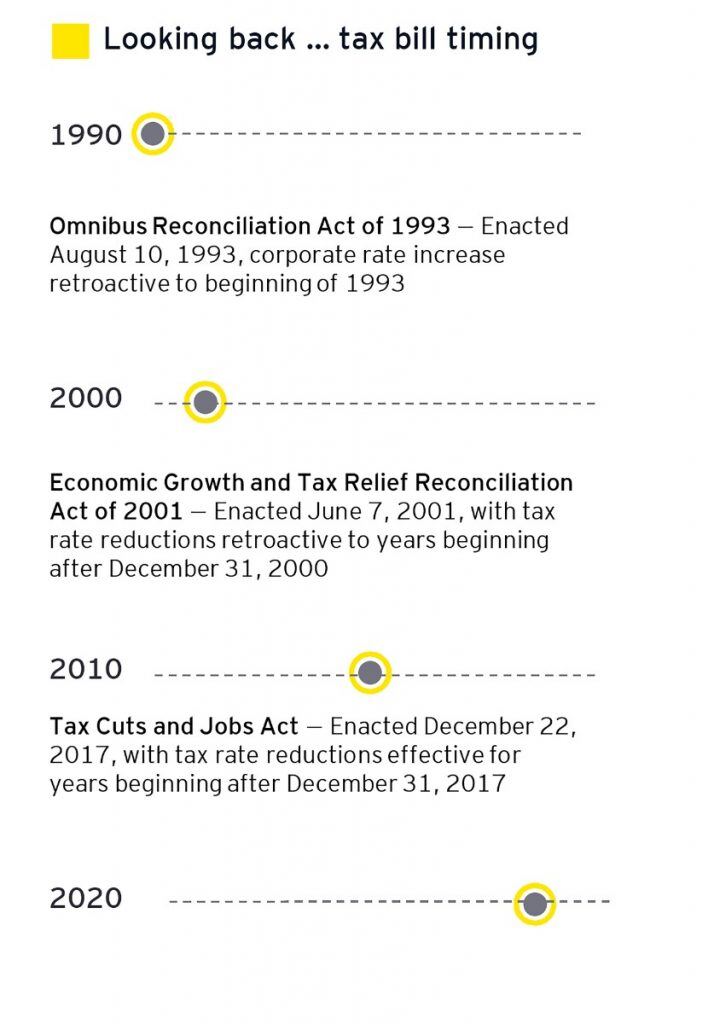
Timing
Whatever the shape of a first economic bill, it will likely
take several months to pass. With Republicans in control in 2001, it took until
Memorial Day to get the first Bush tax cut bill (Economic Growth and Tax Relief
Reconciliation Act (EGTRRA)) done. Under GOP control again in 2017, detailed
tax reform proposals came out November and then there was a legislative sprint
until the end of the year. The last previous change to the statutory corporate
income tax rate (an increase) was in the Omnibus Budget Reconciliation Act of
1993, which wasn’t enacted until August of that year.
Also of interest is the matter of the effective date,
especially as it relates to potential increases in the corporate rate. The 1993
corporate rate change, the last before the TCJA, took effect retroactively to
January 1, 1993, although it was only a one-point increase. The 2001 Bush tax
cuts (EGTRRA) were retroactive to the beginning of the year. The TCJA was
immediate but not retroactive, and that was a rate cut. The current thinking is
that a significant tax bill would take well into 2021 to complete, with an
effective date of the beginning of 2022.
Conclusion
While exact plans of Democrats, should they control Congress
and the presidency in 2021, will continue to develop in the months ahead, they
will likely depend in part on the state of the economy at that time. A
near-term economic bill could be expected with follow-on legislative efforts
addressing additional Democratic priorities. The early priority is likely to be
COVID-19 recovery and other stimulus. Infrastructure investments will be a
priority, as will proposals related to climate change. Some “low-hanging fruit”
tax provisions could be tapped as an early revenue source and the first shot at
improving tax fairness.
Action could follow later on long-held priorities that are
made more urgent by the virus and its effect on the economy, like shoring up
the social safety net, health care and education. Tax proposals are likely
to eventually be tapped for revenue, in the fashion Biden has taken during the
campaign: eschewing a wealth tax or other new concepts in favor of base
broadening, loophole closing and turning the tax rate dials. Based on Biden’s
comments during the campaign, tax increases that could be turned to for early
revenue include repealing the preferential tax treatment capital gains for
higher-income individuals, ending estate tax stepped-up basis and, perhaps,
long-time Democratic targets like carried interest. These could be the first
steps toward the rebalancing of the tax system to which Democrats aspire, with
a corporate tax rate increase and other more systemic changes perhaps facing a
slightly longer runway for enactment.
Sources
1 CBO, “Options for Reducing the Deficit, 2019 to 2028,”
12/13/18
2 Bloomberg, “Biden to Target Tax-Avoiding Companies
… ,” citing Biden campaign officials, 12/4/19
3 JCX-53-19 (Joint Committee on Taxation score of House
State and Local Tax bill)
4 Sanders campaign
5 Warren campaign
6 Senate Finance Committee ranking member Ron Wyden (D-OR),
September 2019 white paper
7 Tax Policy Center analysis of Biden plan
Summary
While Biden has not released a comprehensive campaign tax
plan, what has been put forward harkens back to the pre-Tax Cuts and Jobs Act
(TCJA) playbook: tax increase proposals from a time when deficits from the
previous recession were the subject of fierce partisan battles. If control
shifts Democratic but the economy is still ailing, raising taxes for deficit
reduction may, however, take a back seat. Likewise, if President Trump wins
reelection and Republicans still control the Senate, any focus on tax is likely
to be on refining and/or making permanent TCJA provisions, not addressing
deficits.